Itinerary edited by UNIVERSITY OF PERUGIA 

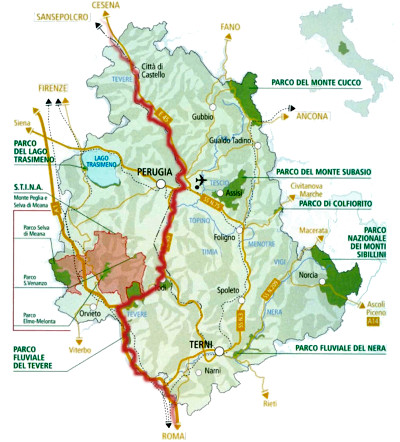
Images of the concerned environment:
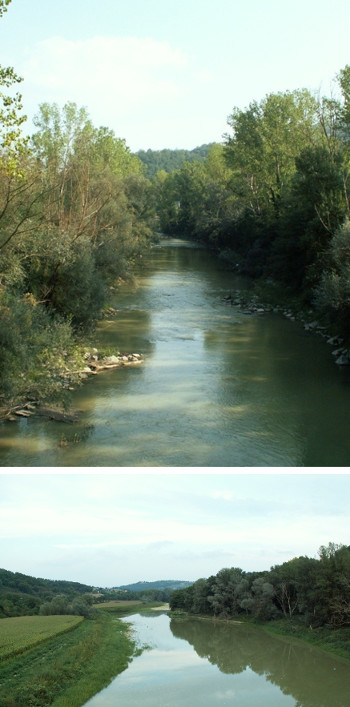
The river Tiber, the longest river in the Italian peninsula, flows through the entire region of Umbria and strongly impacts upon its geography, climate and ecology. In spite of human activity and ensuing changes in ecology and transformation of the environment which, over time, have involved most of the Tiber river basin, tiny areas of relatively untouched environments still exist which are rich in bio-diversity.
The strips of marshy woods and river-bank thickets, small pools and their surrounding wetland borders of luxuriant water plants which extend along some stretches of the Tiber river-banks constitute a refuge and food source for many species of animals, especially birds that live along river-banks and on flood plains . Moreover, the whole Tiber valley is one of the most popular routes for migratory birds in the central regions of the Italian peninsula.
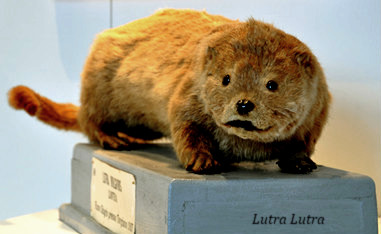 Unfortunately many animal species were unable to survive the environmental deterioration in large areas of the Tiber basin and have become extinct over the last few centuries. One of these was the otter, (Lutralutra), a true symbol of “lost bio-diversity”.
Unfortunately many animal species were unable to survive the environmental deterioration in large areas of the Tiber basin and have become extinct over the last few centuries. One of these was the otter, (Lutralutra), a true symbol of “lost bio-diversity”.
Typical species:
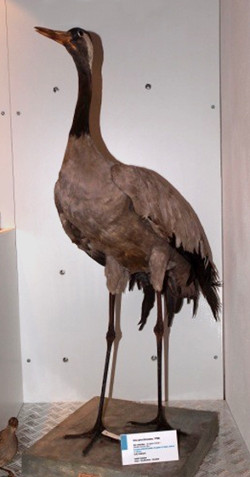
The common crane ( Grus grus )
A large water bird (105/115 cm in length, weighing 5500 g) the common crane has a graceful neck and long legs. Its plumage is grey with clear black and white streaks on its head and neck and a bright red crest. Its tail consists of very long drooping, secondary rudder feathers
This majestic wading-bird is found from Scandinavia to Siberia in the temperate-cold northern and sub-arctic regions. It nests in the tundra and in grassy clearings in the vast pine forests of the European and Asiatic taiga. A migratory species, it winters in Mediterranean countries and tropical Africa. It is sighted in Italy in the autumn from the end of September to mid-October and in the spring from the end of February until May. Sightings are however rare and becoming less frequent.
Cranes were found in Umbria in the past, as confirmed by stuffed birds in ornithological collections in, for example, the natural history gallery in Perugia University’s Scientific Museum. One exemplar dated the end of the 18th century in the OrazioAntinori Collection came from the Tiber River valley, not far from the town of Perugia.
Centuries of over-hunting and aquatic eco-system devastation, particularly of the wetlands and marshy areas of the great flood plains have, unfortunately, greatly reduced the number of these interesting birds. They are now detected only occasionally by their footprints although there have been some recent reports of cranes resting temporarily for a few days in the Upper Tiber valley and near the Colfiorito marsh. Crane sightings are more common in the Maremma Toscana wetlands along the Tyrrhenian coast, mainly in the Grosseto area.
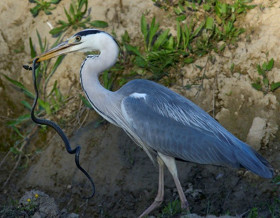 The grey heron (Ardea cinerea)
The grey heron (Ardea cinerea)
A very large member (90 cm in length, weighing 1600 g) of the heron family (Ardeidae) the grey heron has a long neck, a tapered head, a sharp, narrow beak and very long legs. Its typical feature is its ash grey plumage with white underparts. Its white head carries a crest of elongated black feathers and the lower part of its white neck is marked by vertical black streaks. Its wide wings are grey with primary rudder feathers in black. Immature birds are similar to the adult of the species but have a more uniform grey plumage.
The grey heron is widely found all over Europe, Asia and Africa, from Scandinavia and Siberia to the temperate zones and the sub-tropical and tropical regions of southern Asia and sub-Saharan Africa. Diverse aquatic environments constitute its habitat: salty coastal lagoons, river mouths and deltas, wetlands on plains and in mountainous regions, lakes, ponds, marshes, rivers, even smallish streams. It nests in particularly favourable areas like lake or river basins that are surrounded by thick aquatic vegetation or in river-bank woods of willow and poplar. Herons use plant material to build large colonies of nests in the upper branches of tall trees.
Unless persecuted by humans, the heron as a very adaptable species, does not scorn environments with a heavy human activity footprint like artificial canals, irrigation ditches, paddy-fields, pools in green urban areas, coastal ports, anywhere it can find enough food. It feeds mainly on small to medium sized fish, amphibious animals, reptiles, other birds and small mammals. Herons from northern latitudes tend to migrate south during the cold winter months but birds in central-southern Europe, especially in countries with a Mediterranean-type climate, are not migratory. .
Herons are rather common in several areas of Italy, such as the wetlands of the Po flood plain, the coastal lagoons of the upper Adriatic Sea, internal river valleys and the Maremma.
In Umbria herons are found in the Lake Trasimeno basin, and along the banks of the River Tiber and its tributaries where they prefer tracts that conserve river-bank shrubs and woods. The grey heron continues to survive in not a few areas of the Tiber valley, the suburbs and in degraded environments. It has almost become a symbol of resistance by nature in the wild.
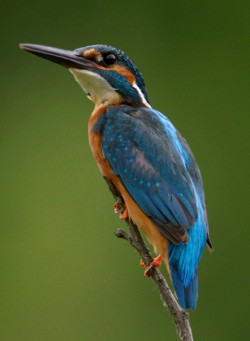 Kingfisher (Alcedo atthis)
Kingfisher (Alcedo atthis)
A true winged jewel among local waterfowl, this small bird (16 cm in length, weighing 35 g) is characterised by its beautiful, blue-green plumage. The upper body has an iridescent metallic sheen, while the lower parts are shiny chestnut brown. Areas of small white feathers are present on the sides of the neck, throat and chin. The roundish head has a rather long, strong beak, with a sharp tip, perfectly suited to capturing the small fish on which it mostly feeds, diving headlong into the water from branches overhanging the banks of the wetlands.
Kingfishers have a wide distribution across Eurasia and North Africa, where they are present in many different aquatic environments, from brackish coastal lagoons to lake basins, marshes, ponds and inland rivers. They are also known to frequent artificial canals and stretches of river in urban centres. The populations of the northernmost regions are migratory, while those in southern Europe and the Mediterranean Basin are sedentary. The Kingfisher nests in the spring, digging narrow tunnels in areas of friable substrate, such as the high banks of waterways. The tunnels end in a small incubation chamber for their eggs. The excavation is carried out with strong pecking by both sexes. The couple then alternates in both the incubation and the care and feeding of the young.
In Italy the kingfisher is still a fairly common species, which prefers rivers and streams with good water quality and rich riparian vegetation. Kingfishers have also been observed in urban areas, such as along the river Tiber in Rome, and the Arno in the historic centre of Florence.
In Umbria the kingfisher is considered a sedentary species, and is relatively common in the Lake Trasimeno basin, and along the river Tiber and its reservoirs, such as the lakes of Corbara and Alviano.